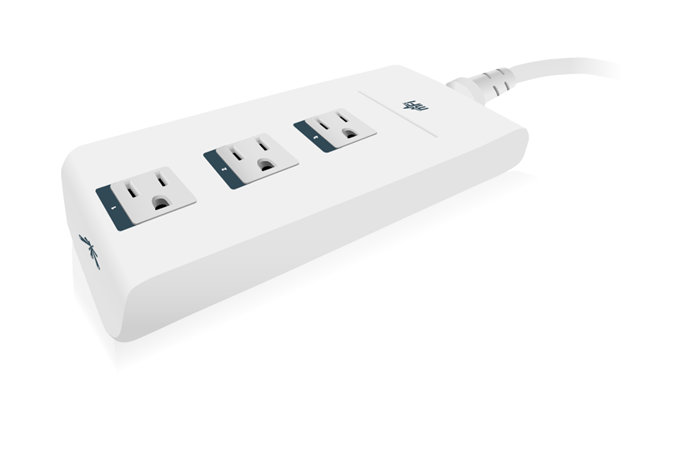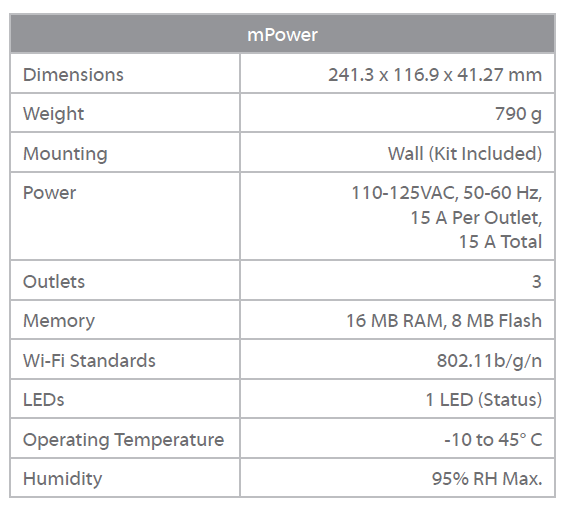Ubiquiti Networks mFi mPower Wi-Fi Power Strip Review
by Ganesh T S on November 21, 2013 3:00 AM EST- Posted in
- Home Automation
- Wi-Fi
- Ubiquiti Networks
- IoT

Introduction
The Internet of Things (IoT) revolution is happening right now. As smartphones proliferate, consumers want the ability to control devices in an automated and easy manner. Remotely switching a power outlet is one of the basic building blocks of an automation system (home or business building). Last year, we reviewed Visible Energy's UFO Power Center, a standalone device which combined energy awareness and home automation in a striking package. Today, we are looking at Ubiquiti's mPower mFi power strip. This is a device with similar features (ability to turn on/off an outlet over a wireless network and measure the power consumed by a device connected to an outlet). However, it caters to a very different market segment.
Ubiquiti Networks - Background
Ubiquiti Networks started off as a manufacturer of wireless products for enterprises, aiming mainly at emerging markets. We have generally found that their kits cost much lower than the competition (and it is attributed mainly to the fact that they don't employ a dedicated sales / marketing team). A couple of years ago, Ubiquiti started looking into expanding their product portfolio. One of the under-served product categories amongst businesses (Ubiquiti's target customers) is that of building automation. As home automation picks up steam, building automation (a term that I will use to talk about home automation technologies from the perspective of an office building) can be expected to follow. Ubiquiti launched the mFi product category to catch this wave. Ubiquiti calls the mFi as the reinvention of machine-to-machine (M2M) communication.
mFi - A Platform for Building Automation
The mFi product category consists of three main products, the mPort, mPort Serial and mPower. A number of sensors (under the mSensor category) are also included, and these interface with the mPort units through a Cat 5 cable. These include door sensors, motion detectors (both wall and ceiling varieties), temperature and current sensors. The mPort Serial provides a remote serial connection for any other devices controllable through a serial interface. Control of multiple such devices is integrated in a management software called mFi. Written in Java, it is compatible with multiple platforms.
Introducing the mPower
The product we are going to cover in detail today is the mPower. It comes in three variants, all of which support connection to a Wi-Fi network. The fundamental difference is in the number of switchable outlets. The mPower Mini has one, the mPower has three and the mPower Pro has eight. The mPower Pro also has a wired network port. Simply put, the mPower units allow the outlets to be turned on / off over the network using the mFi management software as well as a web interface. Essential statistics about each outlet (VRMS, IRMS, power factor and active power) are also reported through both avenues.
The mPower retails for around $60. The mFi controller software is bundled free with the unit. The mPower Pro (8-outlet version) retails for around $100, which represents better value per outlet. However, the Pro units were not easy to source since Ubiquiti had some supply constraints. Ubiquiti's products are not present in the usual retail channels. Instead, they are sold by B2B vendors (who sometimes have a presence on Amazon). The specifications of the mPower, as provided by Ubiquiti, are presented in the table below.

In the remainder of this piece, we will look at the setup and usage impressions, followed by details of the mPower platform. We will also present one of our custom applications developed for the mPower, thanks to its open platform. This will be followed by a few concluding remarks summarizing the pros and cons of the unit.










61 Comments
View All Comments
Daniel Egger - Thursday, November 21, 2013 - link
So how much is the power consumption of the device itself? Can WiFi be turned off on the Pro version? Why does the European version need to be so ugly? Questions and more questions...ganeshts - Sunday, November 24, 2013 - link
Replied to another poster - the power consumption is less than 1 W at idle, but with the network interface up. Wi-Fi can be turned off -- after all, you have SSH access to the unit - you can do anything you want to be done on a persistent basis using some scripts to run on the device at start time.clarkn0va - Thursday, November 21, 2013 - link
"The mFi controller software (Windows version) needs rework for better stability"FTFY. I haven't used the mFi software yet, but UBNT's controller software (Unifi, AirVision, AirControl) is well known for running much better on Linux than Windows. Each product has its own development team, but they pretty much all install great on Linux hosts and start automatically as a service.
Meanwhile, the Windows version tend to suffer from installation difficulties, stability problems, and the number one complaint in the forums probably being the fact that they aren't designed to run as a service, meaning that you have to actually log into Windows and run the executable before you can connect to it. This shortcoming has been worked around by users in the case of most of the products (thank goodness for the open nature of UBNT's software product development), but the "easy" way to use UBNT's software controllers, ironically enough, is to run them on Linux.
I realize Anandtech caters to the Windows crowd, but it's not fair to say that a product is unstable when the Linux version isn't, or incompatible when it's available on Windows, Mac and Linux.
dylan522p - Thursday, November 21, 2013 - link
I like ganesh and many of his articles, but this has to be one of your worst articles ever. I really hope you do not fall and.continue to post article of this level because it honestly is a shame to the Anandtech name to have things like this posted.dac7nco - Friday, November 22, 2013 - link
Ganesh, most UPS have at least ethernet+RS-232, and most I've used connect to a switch or router for management, and a PDU for rack management... This is not new stuff, enabling and disabling power connections, nor are WiFi consoles... I've been doing it since 1995.......Daimon
ganeshts - Friday, November 22, 2013 - link
Daimon, I think the integration with mFi which allows rules creation is the primary aspect here. Of course, the reason we even wanted to get this unit in is because of its power measurement capabilities (real-time). And the clincher is the price point!We have looked around quite a bit for automating our lab infrastructure and measuring power consumption of various devices during different modes of operation. For example, over the last one year, all the power consumption numbers that I have reported have been gathered through the UFO Power Center. In the future, I hope to use either the UFO Power Center or the mPower unit.
Please do point me to any UPS / PDU combo which can solve the remote switching as well as power consumption measurement problem for us at this price point, and I am pretty sure both us and other readers will be happy to check those out.
dac7nco - Friday, November 22, 2013 - link
Checkout Cyberpower and APC; these guys "pure-sine wave" products are leaps and bounds above trip-lite. What you are looking for are their systems which have management consoles; hook to switch with a $2 cat-5 and you're done. Your various sytem/rack-peripheral is offline for maintenance on your own terms. Combine this with IPMI (on your switch)and you manage not only power/power-states/RDP, but you have an IP address for power AND management. Win Win.Daimon
ganeshts - Friday, November 22, 2013 - link
Do those vendors have any products which are sub-$200 and can still do real time power measurement? The last I checked, they do have $800 - $1K PDUs with management consoles, and even those do not have real time power measurement capabilities on a per-outlet basis.dac7nco - Friday, November 22, 2013 - link
Yep. USB power reporting.http://www.newegg.com/Product/Product.aspx?Item=N8...
ganeshts - Friday, November 22, 2013 - link
I looked into the Cyberpower PowerPanel manual, but it is still not clear whether one can log the power consumed by each outlet at configurable intervals / there is a simple API or HTTP query that one can use to poll these values. There is no information on how often these power consumption values get updated too.Otherwise, yes, these UPS management softwares seem to be really feature heavy. As I see in the Newegg comments, $170 is not going to give a network port -- but I can definitely see the appeal for the usage scenario where a UPS is required along with remote switching capabilities
For this product, the appeal would lie in the fact that the unit runs Linux, one can run custom scripts inside the unit and finally, for our purpose, provide an idea of real-time power consumption with high accuracy and with open APIs. Other than the UFO Power Center and the mPower units, I can't see other good alternatives for the feature set. (The UFO Power Center doesn't run Linux, though, but, can be accessed through simple HTTP commands)